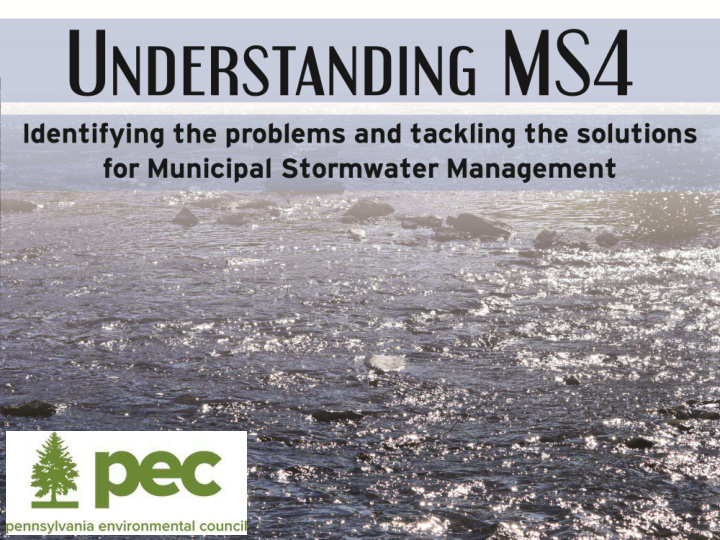



CWA : Clean Water Act NPDES : National Pollutant Discharge Elimination System MS4 : Municipal Separate Storm Sewer System PAG-13 : Pennsylvania General Permit SWMP : Stormwater Management Plan MCM : Minimum Control Measures BMP : Best Management Practices TMDL : Total Maximum Daily Load
Municipal Separate Storm Sewer (It sounds cooler than MSSS)
Municipal Separate Storm Sewer (It sounds cooler than MSSS) System owned or Does not connect to Drains, ditches, operated by a the sanitary sewer curbs, and gutters public agency, system and does that move stormwater such as a city, town, not lead to a from one place to county, flood control wastewater another district, state, or treatment plant federal agency
1972 Clean Water Act Regulate pollutants discharged into water Implement pollution control programs Fund sewage treatment plant construction under the construction grants program Recognized the need for planning
1972 Clean Water Act Good start, but… Two of every five waterways are still considered to be impaired by pollution What’s the problem? STORMWATER RUNOFF
Pennsylvania Water Quality ALU Sources • 86,000 Str • Ag Agri ricultu ture re tream am mi miles • AM AMD • Urb rban an Runoff • 83,438 Assessed Aquatic Life • 16,000 (19%) Causes Impaired • Silta tati tion • Meta tals • 5,000 • pH pH Assessed Recreation • Nutr trients ts • Wat ater r • 1,800 (36%) - Flow/Va Vari riab ability ty Impaired Source: DEP 2014 Pennsylvania Integrated Water Quality Monitoring & Assessment Report
Status of Aquatic Life Use Source: DEP 2012 Pennsylvania Integrated Water Quality Monitoring & Assessment Report
Federal Regulation Time Line 1990 1972 NPDES Ph 1 - medium Clean Wa Water A Act to large cities – CSO 1987 1999 Section 319 319 NPDES P Ph 2 – MS MS4 establishes National (municipal separate program to control storm sewer systems ) NPS pollution and - townships/boroughs grants
Pennsylvania Regulation Time Line 2002 PA PA issues f first Ph t Phas ase 2 2 2012 (Municipal Stormwater Separate Storm Sewer 946 946 Permits System) permits Submitted 2013 2011 PA conti PA tinues to to PA updat PA ates Ph Phas ase 2 2 General al review permits; 30% Permit ( (PAG-13) 13) approved
PA MS4 Communities
Close-up on Philadelphia Region
Minimum Control Measures in your Stormwater Management Plan (SWMP) MCMs in your SWMP Public education and outreach Public involvement and participation Illicit discharge detection and elimination Construction site runoff control Post-construction stormwater management in new development and redevelopment Pollution prevention and good housekeeping for municipal operations and maintenance
Every MCM has its BMPs Public education and outreach Educate the community on the pollution potential of common activities Create a plan Increase awareness of links between land ID audiences (business, homeowners, activities, and local water resources schools) Give the public specific actions that reduce Newsletter stormwater pollution-potential Distribute educational materials
Every MCM has its BMPs Public involvement and participation Facilitate opportunities for direct action and volunteer programs Develop written program Establish watershed groups and Public review of ordinances conservation corps teams Involve target audiences Develop citizen positions on a local stormwater management panel
Every MCM has its BMPs Illicit discharge detection Develop a storm sewer system map Develop an ordinance prohibiting illicit discharges Create a plan to detect and address these illicit discharges Start an education program on the hazards associated with illicit discharges
Every MCM has its BMPs Construction site runoff control Develop requirements to implement erosion and sediment control BMPs Establish ordinances and procedures for reviewing construction site plans Establish procedures for inspections and enforcement of stormwater requirements at construction sites.
Every MCM has its BMPs Post-construction SWM Create strategies to implement a combination of structural and non-structural BMPs Develop an ordinance to address post-construction runoff at new developments Establish a program to ensure adequate long-term operation and maintenance
Every MCM has its BMPs Pollution Prevention Develop inspection and maintenance procedures and schedules for SWM BMPs Treat pollutants from transportation infrastructure, waste transfer stations, etc. Establish procedures for properly disposing of pollutants removed from the MS4 Identify ways to incorporate water quality controls into flood management projects.
Is my municipality eligible for coverage under PAG-13? Are any of your small No MS4 Permit is needed MS4s regulated? No Yep Does your regulated MS4 You must apply for an meet all criteria for individual NPDES MS4 No General Permit Eligibility? Permit Yep Your municipality is eligible for coverage under PAG-13!
Municipalities are required to submit a Notice of Intent (NOI) 1.) Multi-Municipal Joint Application 2.) MS4 Operator Information 3.) Urbanized Area Information 4.) Description of Receiving Waters 5.) Stormwater Management Program Plan NOIs have a timeline of 5 years
Stormwater Management Program Plans must: Contain measurable goals for the six MCMs Contain Best Management Practices for each MCM Enact or implement either: An MS4 Stormwater Management Ordinance A Model Ordinance from an applicable Act 167 Stormwater Management Plan An ordinance that satisfies an MS4 Stormwater Management Ordinance Checklist Submit a MS4 TMDL Plan if applicable
Total Maximum Daily Loads Designated Uses • Maximum amount of Agriculture pollution that a water body can Aquatic life receive and still meet water Recreation quality standards Water supply
Total Maximum Daily Loads Calculations consider: – Point source pollution – Non-point source pollution – Background – Margin of safety factor
Total Maximum Daily Loads • Impaired waterways require pollution reduction plans; MS4s considered point source. • Tool to address past impacts. Wissahickon has sediment TMDL: – Munics submit TMDL Plan with MS4 permit – Show measureable progress (e.g. lbs. sediment/year reductions) – Control measures: riparian forest buffers, tree planting, stormwater basin retrofits, restored stream bank…
Recommend
More recommend